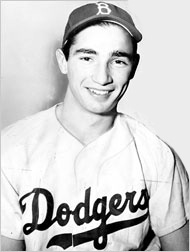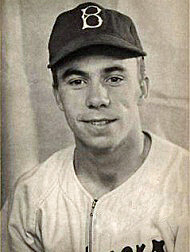We all know how fishermen always tell about the big one that got away. We might even be one of those fishermen. Well, the Dodgers let one get away and all the baseball world remembers the story. Roberto Clemente was the big one, snatched up by Branch Rickey and the Pirates in 1954 when the Dodgers left him unprotected and tried to hide him away on the bench with the Montreal Royals. He became the greatest ever Rule 5 acquisition.
One common refrain in the world of baseball is , “You can’t win ‘em all.” On the other hand, while that is absolutely correct, two out of three isn’t bad; especially if the two are Sandy Koufax and Pee Wee Reese. All the baseball world doesn’t remember those stories.
Koufax, a Brooklyn boy, excelled in basketball and baseball with Brooklyn’s Lafayette High School. He actually went. to the University of Cincinnati on a basketball scholarship. However, the baseball scouts were hot on his trail and baseball was to become the domain he owned for six marvelous years as a Dodger.

Former Dodgers GM Branch Rickey may have found Jackie Robinson, but he waited too late to sign Sandy Koufax when he was the Pirates GM in 1954. (AP photo)
Sandy Koufax attracted considerable attention in 1954. He had tryouts with the New York Giants who apparently had little interest in him, the Pittsburgh Pirates who were very interested in signing him and the Brooklyn Dodgers who did sign him.
Branch Rickey, the former Dodger general manager, had become the Pirates general manager in 1950. Rickey dispatched his son and his most trusted aide Clyde Sukeforth to have a look at Koufax. Even though he had an extremely poor outing in a sandlot game, exhibiting the wildness that plagued him for some time and generally getting beaten around, Sukeforth was impressed. with the young lefty. Sukeforth felt the wildness at Koufax’s age was not unusual and he was invited to try out for the Pirates. Branch Jr. was not as impressed.
That tryout was arranged in front of Branch Rickey. Sukeforth reported Rickey as saying: “This is the greatest arm I have ever seen.” However, a contract offer was not made to Koufax but a second trip to Pittsburgh was arranged. This time the ball literally exploded out of his hand and one of his pitches broke catcher Sam Narron’s hand. Apparently Branch Rickey Jr. remembered seeing Koufax get shellacked at the sandlot game at Dyker Field and discouraged his father from signing him. Branch Rickey was known to pinch a penny and perhaps with his son’s concern in mind, he offered Koufax $15,000. The offer was refused and by the time John Galbraith, Pirates owner, came back with a $20,000 offer it was too late.
In the meantime Dodger scout, Al Campanis (some say on a tip from a sporting goods store owner), watched Koufax pitch in a local game. Campanis quickly invited him to a tryout at Ebbets Field. Scouting director Fresco Thompson and Walter Alston, Dodger manager, looked on as Koufax threw with Campanis in the batting box in a hitter’s stance. Campanis later said: “There are two times in my life the hair on my arms has stood up: The first time I saw the ceiling of the Sistine Chapel and the first time I saw Sandy Koufax throw a fastball.” The Dodgers signed Sandy for $20,000. He received a $14,000 bonus which prevented the team from sending him to the minors and a $6,000 salary.
The second big fish reeled in by the Dodgers was none other than Pee Wee Reese. Harold Henry Reese – from Louisville, Kentucky – became known as the “Little Colonel” and more appropriately, the “Captain.”

Tom Yawkey actually purchased the Boston Red Sox just so he could have exclusive rights to Pee Wee Reese; however, Yawkey eventually sold Reese to the Dodgers at the urging of the man Reese would have replaced.
(AP photo)
He played church league baseball in Louisville and his skill didn’t go unnoticed. In 1937 his New Covenant team captured the Louisville City League Championship. The Louisville Colonels quickly snatched up Reese following the championship game signing him for a $200 bonus and a promise of $150 a month.
The Colonels played in the American Association which was equivalent to today’s AAA classification. At that point the Colonels would also be the equivalent of an independent league team today. They were not affiliated with any major league baseball team and could acquire their players from any number of different teams. Conversely they were not restricted to selling contracts to only one team.
In 1938 Reese had a batting average of .279 and stole 35 bases in 36 tries. As a nineteen year old he was voted to the American Association All-Star team. Opposing managers described him as the best infielder in the American Association, despite his youth.
Following the 1938 season the Louisville team was purchased by an unidentified group of businessmen. The identity of the purchasing group was intentionally kept ambiguous but eventually it became known the team had been bought by Boston Red Sox owner Tom Yawkey. Yawkey bought the entire team for one reason and one reason only – Pee Wee Reese. That was his guarantee that no other team could acquire Reese. Yawkey’s scouts had given glowing reports on Reese assuring him that the young shortstop had the makings of a great major league player. The scouts were definitely on the right track with Pee Wee Reese.
Having had an entire team purchased to gain his rights, Pee Wee Reese seemed to be a sure bet to join the Red Sox, perhaps as early as 1940. However, that was not to happen. Joe Cronin, the long time Red Sox shortstop stood in the way. It was not because of his stellar play in the field, which was definitely sub-par but Cronin (32) was still a good hitter. More importantly, he was also the Red Sox manager. A man of pride, Cronin simply couldn’t stand the thought of being beaten out by a youngster. Even though Boston scouts continued to see Reese as a budding superstar, Cronin convinced owner Tom Yawkey that Reese was just too small and sickly-looking to play in the big leagues although he was not small for a shortstop at 5’ 10” and 160 pounds.
As those events unfolded Branch Rickey quickly swooped in and Pee Wee Reese was sold to the Dodgers. Tom Yawkey tried to recoup his Louisville investment by selling Reese to the Dodgers for $35,000 and Branch Rickey bought the greatest shortstop in Dodger history for $35,000. He did break into the majors with the Dodgers in 1940, and coincidentally or not, the Dodgers began their ascent from cellar dwellers to perennial contenders in Brooklyn.
Two our of three really isn’t so bad.
Note: Reese had been signed by the Pittsburgh Pirates as an amateur free agent before the 1938 season but his rights were returned to the Louisville Colonels following the season.




 February 23rd, 2013 at 5:32 am
February 23rd, 2013 at 5:32 am  by Harold Uhlman
by Harold Uhlman  Posted in
Posted in 

Great article Harold and a real education.